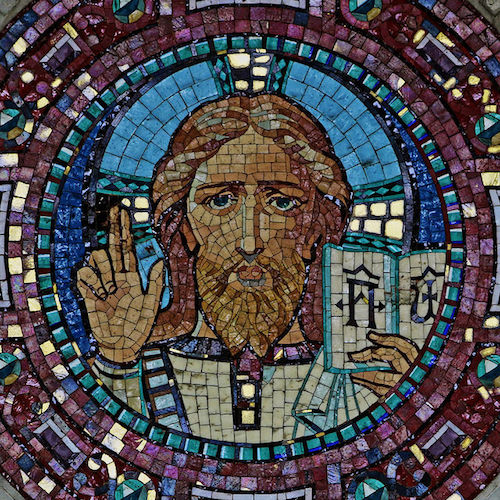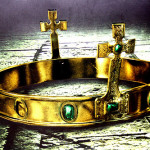We run our website the way we wished the whole internet worked: we provide high quality original content with no ads. We are funded solely by your direct support. Please consider supporting this project.

The Centrality of Christ in Hebrews, Part 1
The intense Christocentricity that the New Testament writers embrace is nowhere more clearly and consistently illustrated than in the book of Hebrews. Throughout this work we find a repeated emphasis on the many ways the revelation given to us in Christ surpasses that of the Old Testament. The author begins by stressing how the revelation of God in his own Son contrasts with and surpasses all previous revelations by virtue of the fact that the Son alone is the “radiance of God’s glory” and the “exact representation of his being” (Heb. 1:3). Consistent with this, the first ten chapters of this work are structured around Christ’s superiority:
- to angels, (1:5-2:18)
- to Moses (3:1-4:13)
- to the Aaronic Priesthood (4:4-7:28)
- to the High Priests and their sacrifices (chapters 8-10)
Reflecting this same perspective, the author sees the tabernacle erected by Moses to be a “copy” and “shadow” of the “true tabernacle set up by the Lord” (8:1-6). So too, the activity of the high priest on the day of the atonement in the OT was, for this author, the Holy Spirit’s way of “showing … that the way into the Most Holy Place had not yet been disclosed.” It thus serves as “an illustration (parabolē) for the present time” of the inferiority of the OT practices and the superiority of the sacrifice Christ makes and of the new covenant he brings (Heb. 9:8-28).
In the same way, the author of Hebrews held that “the law is only a shadow of the good things that are coming—not the realities themselves,” for the law could never “make perfect those who draw near to worship” (10:1). Only the sacrifice of Jesus—the reality to which the law and everything else in the OT points—can perfect people before God once and for all (10:10,14).
Given this perspective, we are hardly surprised to find this author discerning Christ in a wide array of OT passages. Let’s look at the opening chapter as a prime example. The author of Hebrews begins by interpreting the song that was sung at the coronation of a king (Ps. 2:7) to be a song about the enthronement of Christ (Heb 1:5). The author then goes on to demonstrate the superiority of Christ over angels by applying a reworked version of Psalm 104:4 to angels, showing them to be mere servants of Yahweh, while applying Psalm 45:6-7 to Christ, for this latter Psalm is a tribute to “God” whose “throne … will last forever and ever” (Heb 1:7-8).
And finally, to buttress Christ’s superiority over angels even further, this author goes on to apply to Christ a song about Yahweh’s work as Creator (Heb 1:10, cf. Ps 102:25-27). The circular way this author uses Scripture to prove Christ’s superiority simply reveals that he is approaching the OT with the assumption that it is a collection of works that is about Christ.
In the next post, we will explore a few more examples of how the writer of Hebrews puts Christ at the center of the Old Testament.
Photo credit: Leo Reynolds via Visual hunt / CC BY-NC-SA
Category: General
Tags: Bible Interpretation, Christocentrism, Cruciform Theology, New Testament, Old Testament
Topics: Christology
Related Reading

Does God Inflict Physical Disabilities?
In Exodus 4, we find Moses claiming that he could not be used by Yahweh to get the children of Israel out of Egypt because he was “slow of speech and tongue.” To this Yahweh replies, “Who gave human beings their mouths? Who makes them deaf or mute? Who gives them sight or makes them…

What Kind of God Did Jesus Reveal?
The ReKnew Manifesto exists to encourage believers and skeptics alike to re-think things they thought they already knew – hence our name, Re-Knew. I am currently working through the theology of the Manifesto in a series of posts that began a couple of months ago. Over the last few posts, we have been looking at the…

Did God Want a King for Israel?
By the time God was ready to form a nation for himself by delivering the Israelites from the oppressive rule of the Egyptian Pharaoh, every nation was ruled by someone and existed in tension with, and often at war with, other nations. Yet, it’s clear from the biblical narrative that God originally wanted Israel to…

Quotes to Chew On: The Cross and God’s Love
“The cross is the central way Christ images God. Christ was not an innocent third party who was punished against his will to appease the Father’s wrath. Christ is himself God, and he voluntarily took our sin and its just punishment upon himself. Hence his sacrifice does not appease God’s wrath; it reveals God’s love.…

Who Curses the Earth?
After the “fall” of Adam and Eve in the Garden of Eden, their sin results in a five curses: on nature, on marriage, on human life, on the serpent, and on women during childbirth. Who is it exactly that afflicts the world with these curses? While the author speaks about the curses on nature (Gen…

The Cruciform Center Part 2: How John’s Gospel Reveals a Cruciform God
In the previous post, we looked at how the Synoptics illustrate the centrality of the cross. While the Gospel of John varies in its structure and language from the Synoptics, the cross remains at the center. This centrality is expressed in a number of different ways. 1. The role that Jesus’ death plays in glorifying…
